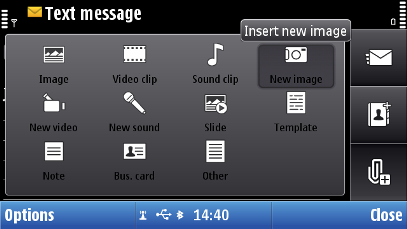Scaling and positioning of controls
Interface elements a user has to select and manipulate should not be smaller than the smallest average finger pad, that is, no smaller than 1 cm (0.4") in diameter or a 1 cm × 1 cm square.
In the Symbian platform, UI style defines the minimum sizes for a UI element considered as finger usable:
7 x 7 mm with 1 mm gaps for index finger usage
8 x 8 mm with 2 mm gaps for thumb usage
List type of components should have minimum of 5 mm line spacing
The width of a finger limits the density of items on screen. If the items are too close, the user will not be able to choose a single one.
As the probability of the user touching the higher end of the button (than on the either side of the key) is high, button and icon sizes can be increased vertically.
Essential information or features, such as a label, instructions, or sub-controls should never be placed below an interface element that can be touched, as it may be hidden by the user's finger.
Following are some useful tips that can be used while placing essential information or features on interface element:With interfaces having input devices, it makes sense to place targets like menu items on the edges of screens because the cursor movement stops at the edge of the screen.
When using a touch screen, a user seldom drags the finger across the screen like a cursor. Instead, they most likely lift their finger and place it on a new target. Users may have difficulties in reaching the objects located on the edges of the screen, especially if the physical device has protruding edges around the touch screen panel. Additionally, with some devices, the screen edges may be less sensitive to register the touch input.
Finger usable UI
Sylus can be used as the input method with touch UI, but events apply to finger use also. However, in some cases the components may not be finger optimized due to the size of objects, for example, virtual keyboard or text field.
In Symbian, UI style defines the target minimum sizes for a UI element considered as finger usable:
7 x 7 mm with 1 mm gaps for index finger usage
8 x 8 mm with 2 mm gaps for thumb usage
List type of components should have minimum of 5 mm line spacing
Targets are general as in practice sizes can be use case dependent, for example, due to frequency of use, efficiency vs. error criticality or ease of error correction, location of the button (edge of screen vs. center).
The visible area of the component and the component's active area should be identical. There are exception cases to this rule though:
When components are located near the edge of the display, the touchable area should extend fully to the edge of the display (beyond the components visible graphics).
Visible area is smaller than the active area in order to keep the balance in look and feel of the UI. For example, scrollbar has wider touch area than visible area.
Active area is smaller than the visible area in order to avoid unwanted presses to contiguous active areas. In this case, there it should be graphically indicated where the user should tap. Example: fixed toolbar buttons in landscape layout.
